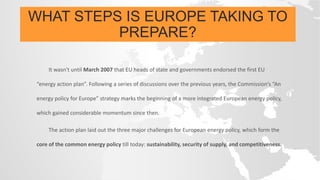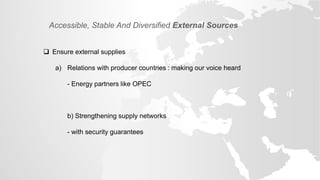Energy
- 1. ENERGY Sustainable, secure and affordable energy for Europeans
- 2. WHAT IS EU ENERGY POLICY AND WHY DO WE NEED IT? Lighting, heating, transport, industrial output: without energy we would have none of these essential day-today services which we and our businesses cannot function. Our stocks of fossil fuels (oil, gas and coal) will not, however, last forever. They need to be managed while we look into new sources of energy.
- 3. Europe is consuming, and importing, increasing quantities of energy. The European Union, the world’s second largest economy, consumes one fifth of the world’s energy but has very few reserves of its own. WHAT IS EU ENERG Y POLICY AND WHY DO WE NEED IT?
- 5. WHAT IS EU ENERG Y POLICY AND WHY DO WE NEED IT? They buy their oil from OPEC (Organisation of the Petroleum Exporting Countries) and Russia, and our gas from Russia, Norway and Algeria. The EU external energy bill represents more than €1 billion per day (around €400 billion in 2013) and more than a fifth of total EU imports. The EU imports more than €300 billion of crude oil and oil products, of which one third from Russia.
- 6. WHAT IS EU ENERG Y POLICY AND WHY DO WE NEED IT? European energy markets face a number of problems: the growing threats of climate change, slow progress in energy efficiency and the use of renewables, the need for transparency, further integration and interconnection of national energy markets and the need for large investments in energy infrastructure. Moreover, Europe has to deal with major challenges in energy supply: the ongoing difficult situation on the oil and gas markets, the increasing import dependency and limited diversification achieved so far, high and volatile energy prices, growing global energy demand, security risks affecting producing and transit countries as well as transport routes.
- 7. WHAT STEPS IS EUROPE TAKING TO PREPARE? It wasn't until March 2007 that EU heads of state and governments endorsed the first EU “energy action plan”. Following a series of discussions over the previous years, the Commission’s “An energy policy for Europe” strategy marks the beginning of a more integrated European energy policy, which gained considerable momentum since then. The action plan laid out the three major challenges for European energy policy, which form the core of the common energy policy till today: sustainability, security of supply, and competitiveness.
- 9. Energy Efficiency by using energy in better and more efficient ways. The European Union has to encourage its member countries to stop energy from being wasted by electrical appliances, industry, transport and buildings.
- 10. A win– win solution: CO2 emissions can be prevented, we become less dependent on energy imports and it may well be possible to create local jobs and export our expertise.
- 12. INTERNAL ENERGY MARKET Electricity and gas can flow freely through the grids across Europe All producers and suppliers compete with one another. Possibility to buy and sell electricity and gas wherever one wants, the aim being to obtain high- quality energy at the most competitive price.
- 13. Energy Trans- European Networks To supply cheap, diversified, and environment-friendly energy Reduce transaction cost Interconnected networks are vital to the development of healthy competition and constitute a prerequisite to successfully creating an internal energy market.
- 14. Up-to-date Energy Grids modernized and developed- to make energy market more fluid. The EU can give its Member States a real helping hand here, as it is in all their interests to develop high-voltage lines and gas pipelines connecting them to one another, and to store energy. investment of around €1 000 billion
- 17. For instance, they should be able to: • readily to switch supplier • receive straightforward bills and offers that can be compared, • find out where their electricity has come from • find out about their consumption at any moment. Consumers are central to concerns
- 18. ENERGY UNION ENERGY EFFICIENCY INTERNAL ENERGY MARKET ENERGY SECURITY DECARBONIZ ATION RESEARCH & DEVELOPMENT • Energy trans- European Networks • Up- to – Date grids • Benefitting consumers
- 19. ENERGY SECURITY Security of energy supply is defined as the ability to ensure the continued satisfaction of essential energy needs by means of: • sufficient internal resources exploited under acceptable economic conditions • accessible, stable and diversified external sources
- 20. Development of less pollutant energy sources • New and renewable energy sources - mobilising aid to promote their development and use. Sufficient Internal Resources
- 21. Renewable energy sources include the following: biomass and wastes: organic, non-fossil material of biological origin, which may be used for heat production or electricity generation; comprises wood and wood waste, biogas, municipal solid waste and biofuels; includes the renewable part of industrial waste; hydropower: the electricity generated from the potential and kinetic energy of water in hydroelectric plants (the electricity generated in pumped storage plants is not included); geothermal energy: the energy available as heat from within the earth’s crust, usually in the form of hot water or steam; wind energy: the kinetic energy of wind converted into electricity in wind turbines; Solar energy: solar radiation exploited for solar heat (hot water) and electricity production.
- 23. Ensure external supplies a) Relations with producer countries : making our voice heard - Energy partners like OPEC b) Strengthening supply networks - with security guarantees Accessible, Stable And Diversified External Sources
- 24. ENERGY UNION ENERGY EFFICIENCY INTERNAL ENERGY MARKET ENERGY SECURITY DECARBO NIZATION RESEARCH & DEVELOPMENT • Securing Internal Supply • Accessible External Sources • Energy trans- European Networks • Up- to – Date grids • Benefitting consumers
- 25. DECARBONIZATION EU Emissions Trading System Encouraging private investment in new infrastructure and technologies. Global Deal For Climate Change
- 28. Encouraging Private Investment In New Infrastructure And Technologies • The goal is to rally industrialists and promote investment in alternative fuels including biofuels. • The aim here is to make these new technologies affordable and profitable
- 30. • The European Union has played a key role in brokering a historic agreement in Paris (2015 Dec), where the first-ever universal, legally binding global climate deal was adopted. • It sets out a global action plan to limit global warming to well below 2°C. Global Deal For Climate Change
- 37. ENERGY UNION ENERGY EFFICIENCY INTERNAL ENERGY MARKET ENERGY SECURITY DECARBONIZ ATION RESEARC H & DEVELOPMENT • Energy trans- European Networks • Up- to – Date grids • Benefitting consumers • Securing Internal Supply • Accessible External Sources • EU Emissions Trading System • Encouraging private investment in new infrastructure and technologies. • Global Deal For Climate Change
- 38. RESEARCH AND DEVELOPMENT Supporting breakthroughs in low-carbon technologies by coordinating research and helping to finance projects in partnership with the private sector Integrated Strategic Energy Technology (SET) Plan • first research and innovation deliverable on which the Energy Union will be built. • help address the challenges which must be met for the transformation of the EU's energy system. Goals: Accelerating knowledge development, technology transfer and up-take; Maintaining EU industrial leadership on low-carbon energy technologies; Fostering science for transforming energy technologies to achieve the 2020 Energy and Climate Change goals; Contributing to the worldwide transition to a low carbon economy by 2050.
- 39. ENERGY UNION ENERGY EFFICIENCY INTERNAL ENERGY MARKET ENERGY SECURITY SUPPLY DECARBONIZ ATION RESEARCH & DEVELOPMENT • Energy trans- European Networks • Up- to – Date grids • Benefitting consumers • Securing Internal Supply • Accessible External Sources • EU Emissions Trading System • Encouraging private investment in new infrastructure and technologies. • Global Deal For Climate Change Strategic Energy Technology (SET) Plan
- 40. To pursue these goals within a coherent long-term strategy, the EU has formulated targets for 2020, 2030, and 2050. The 2020 Energy Strategy defines the EU's energy priorities between 2010 and 2020. It aims to: •reduce greenhouse gases by at least 20% •increase the share of renewable energy in the EU's energy mix to at least 20% of consumption •improve energy efficiency by at least 20% Together, these goals provide the EU with a stable policy framework on greenhouse gas emissions, renewables and energy efficiency giving investors more certainty and confirming the EU's lead in these fields on a global scale. O V E R A L L
- 42. PROGRESS
- 43. ENERGY Mary Ruthie Rutger R. Yours Forever,










































